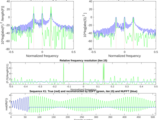Extended DFT
Cite As
Vilnis Liepins (2024). Extended DFT (https://www.mathworks.com/matlabcentral/fileexchange/11020-extended-dft), MATLAB Central File Exchange. Retrieved .
MATLAB Release Compatibility
Platform Compatibility
Windows macOS LinuxCategories
- Signal Processing > Signal Processing Toolbox > Transforms, Correlation, and Modeling > Transforms > Discrete Fourier and Cosine Transforms > Fast Fourier Transforms >
Tags
Community Treasure Hunt
Find the treasures in MATLAB Central and discover how the community can help you!
Start Hunting!Discover Live Editor
Create scripts with code, output, and formatted text in a single executable document.
| Version | Published | Release Notes | |
|---|---|---|---|
| 1.49.3.0 | Add reference to nufft in the edft.m description. |
||
| 1.49.2.0 | Remove function iedft.m as it is covered by adjoint Matlab function nufft. |
||
| 1.49.1.0 | Repeat update of edft2 |
||
| 1.49.0.0 | Update edft2.m |
||
| 1.48.9.0 | Refactoring of edft.m input parameters |
||
| 1.48.8.0 | Change image only |
||
| 1.48.7.0 | edft.m updated to return the frequency set f used in calculations. |
||
| 1.48.6.0 | Image update 2x |
||
| 1.48.5.0 | Domo programs and image updated |
||
| 1.48.4.0 | Minor changes |
||
| 1.48.3.0 | Removed unused output argument in edft.m |
||
| 1.48.2.0 | Demo programs updated |
||
| 1.48.1.0 | edft.m updated to use nested functions |
||
| 1.48 | Improve handling of ill-conditioned matrices in edft.m |
||
| 1.47.9.0 | Stop iteration condition updated in edft.m |
||
| 1.47.8.0 | Function iedft.m updated |
||
| 1.47.7.0 | edft.m updated |
||
| 1.47.6.0 | Minor changes |
||
| 1.47.5.0 | Demo program updated |
||
| 1.47.4.0 | Minor update to edft.m |
||
| 1.47.3.0 | Special case processing updated. |
||
| 1.47.2.0 | Updated help texts and added additional input parameter validations. |
||
| 1.47.1.0 | description updated |
||
| 1.47.0.0 | Program edft.m merged with nedft.m, all functionality is preserved. |
||
| 1.46.5.0 | The demo programs have been updated to compare with the Matlab function NUFFT. |
||
| 1.46.4.0 | cleanup code |
||
| 1.46.3.0 | minor changes after code review |
||
| 1.46.2.0 | Help text updates |
||
| 1.46.1.0 | Mirror corrections |
||
| 1.46.0.0 | Program nedft.m updated |
||
| 1.45.0.0 | Code update for nedft.m and edft.m functions. |
||
| 1.44.0.0 | The default matrix inversion method changed in edft.m |
||
| 1.43.0.0 | Documetation related update |
||
| 1.42.0.0 | A small corrections made in demoedft output. |
||
| 1.41.0.0 | ) |
||
| 1.40.0.0 | Mirror changes |
||
| 1.39.0.0 | Demo files updated |
||
| 1.38.0.0 | Bug in edft.m line 135 corrected. Thanks David M.-S. for your quick response. |
||
| 1.37.0.0 | Minor changes - just a code refactoring. |
||
| 1.10.0.0 | EDFT package updated. Pdf file removed as a latest version of it will be available on arxiv site. |
||
| 1.9.0.0 | Added the link to external document |
||
| 1.7.0.0 | Obsolete finite function romoved from code (thanks Sean for your comment). Documentation updated. |
||
| 1.6.0.0 | mirror changes |
||
| 1.5.0.0 | Update contacts info and pdf file. |
||
| 1.4.0.0 | Programs edft_f2.m and edft_f3.m added |
||
| 1.3.0.0 | Small changes in stopping iterations criteria |
||
| 1.2.0.0 | minor changes |
||
| 1.1.0.0 | Update ExtendedDFT.pdf file |
||
| 1.0.0.0 | Documentation update |

